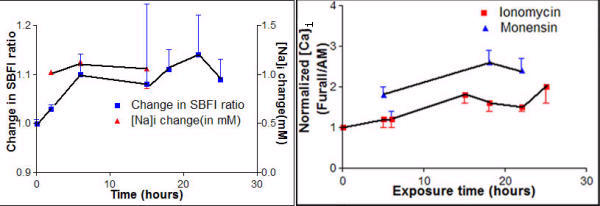Figure 6.

[Na]i and [Ca]i were seen to rise starting 2–6 hrs and stay elevated for up to 24 hrs following exposure of PC3 cells to the antioneoplastics Taxotere or VP16. PC3 cells were plated in black, low autofluorescent 96 well plates. Taxotere (10 nM; solid line) or VP 16 (10 μg/ml; dotted line) was added at indicated times prior to measurement with ion sensing fluorescent dyes for Na+ (SBFI/AM, Molecular Probes; left panel) or Ca++ (Fura II/AM, Molecular Probes; right panel). Following drug exposure and dye loading, plates were run on Titertek Fluoroskan II fluorescent plate reader and ratios obtained from 345 versus 390 nM excitation (with 510 nM emission). Each point represents a minimum of 5 wells; points from each experiment are connected. Calibrations were performed using methods whereby [Ca]i and [Na]i are manipulated with ionophores (respectively ionomycin; monensin) combined with changes in extracellular ions. Statistical confidence on ion change derived from variance of ratios. All mean ion concentrations at 6 hrs or later are greater than control (p < 0.05). Ratios are plotted as changes relative to control. Changes in [Ca]i values are displayed with controls set to 100 (actual mean control was 126 μM). The estimated changes in [Na]i versus control are displayed on separated vertical axes.
